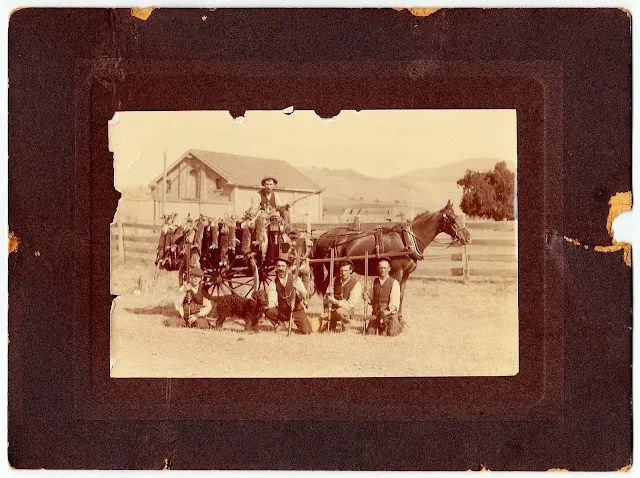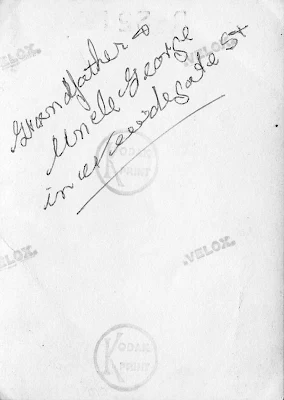One of the earliest legal documents testifying to his support as a photographer by the Colonial Government was signed by his solicitor in 1868, William Robert Giblin, Attorney-General in 1873 and later Premier. W.R. Giblin supported and sanctioned Nevin's commission to provide the police with prisoner identification photographs from the same year, 1873, in which the government adopted amendments to the Victorian Police Act requiring photographic records of criminals. This document, signed by Giblin, was reproduced in The Mercury, 26th February 1868:
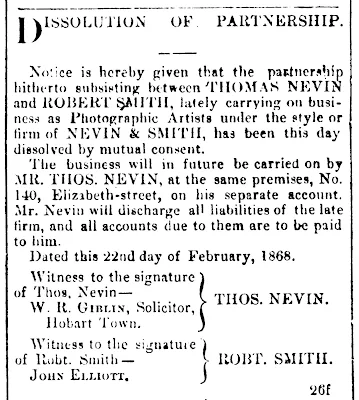
Above: The dissolution of the firm Nevin & Smith, signed by Nevin's solicitor W.R. Giblin, stating clearly that he would ensure all liabilities would be discharged
The last document (to date) of Thomas Nevin's direct involvement with government legislation pertaining to police administration was signed as a resolution on the occasion of a bill to be introduced in the House of Assembly to effectively centralise the various municipal and territorial forces. The meeting he attended and its resolutions, which was chaired by His Worship the Mayor Alderman Crouch, was reported in The Mercury, 19 July 1888. Thomas Nevin's recorded comment was:
"Mr. Thos Nevin was under the impression that the police should be under stricter supervision."

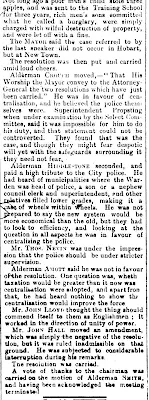
Thomas Nevin at meeting for bill to centralise the police,
The Mercury 19 July 1888.
The newspaper account makes amusing reading. Dr Benjafield complained that because he lived just in the city boundary, the Glenorchy (i.e. Territorial) police would come only as far as the fence, even if he was being murdered. The satirist Tom Midwood, son of Nevin's associate at the Municipal Police Office, Edwin Midwood, published a series of cartoons lampooning the police. This one drew attention to the concentration of power at the Town Hall which would result from the Police Centralisation Bill.

Tom Midwood's satirical take ca. 1888 on the concentration of Authority - the Police, the City Council, and colonial politicians - all under the one roof at the Hobart Town Hall where Nevin worked full-time between 1876-1880. Source: State Library of Tasmania.
FIRST EXPERIENCES
Thomas Nevin's first experiences with policing were at age 10, working alongside his father who was warden of 32 Parkhurst prison juvenile exiles on board the Fairlie on the voyage out from England in 1852 [Sources: AOT MB2/98; NA UK, ADM 101/27/2]
During his teenage apprenticeship years, Thomas Nevin visited the Hobart Gaol and Port Arthur prison with photographers Alfred Bock (1863-5) and Samuel Clifford (1869-73), making cartes-de-visite and cabinet panels of prison officials, prisoners, local identities, and visiting dignitaries, plus stereographs of buildings and scenery around the site. [Sources: Kerr, 1992; Long, 1995, images at SLTas, SLVic, TMAG, QVMAG]
In 1871 he married Elizabeth Rachel Day, a niece of Captain Henry James Day, guard captain of the 99th Regiment , who had arrived on the Candahar with 60 troops and 260 convicts under his command (1842), and had served as well on Norfolk Island (1852). Thomas Nevin's military connections with the convict system were deepened with this liaison [Sources: Hobart Town Courier, AOT Colonial Families Names and Links].
MENTORS
Friends and fellow electors in the Glenorchy district, and neighbours of the Nevin family at Kangaroo Valley, Hobart, where John Nevin, his father, was a Trustee of the Wesleyan Chapel and schoolmaster, were politicians, police administrators and convict system contractors. These men would become mentors, referees and patrons of the young photographer:
- public servant and politician William Edward Nairn (1812-1869). Thomas Nevin photographed William Nairn ca 1868, which John Watt Beattie reprinted ca. 1895:

William Edward Nairn (1812-1869)
Photograph by Thomas Nevin ca. mid 1860s,
Reproduced by John Watt Beattie ca. 1895
State library of Tasmania
Location: Allport Library and Museum of Fine Arts
ADRI: AUTAS001125646943
The Nairns were influential in Thomas Nevin's success in gaining photographic commissions with the Convict Department and the Municipal Police at the Town Hall. William Nairn was assistant comptroller of the Convict Department in 1843, in charge of the prisoners in Tasmania and Norfolk Island. He was departmental registrar in 1855-56 and comptroller-general of convicts at a salary of £800 in 1859-68. He was also sheriff of Hobart in 1857-68. His wife Maria Nairn was a sister of John Swan, Inspector of Police in the 1870s. When her husband died, his estate of £2200 in Tasmania and £4400 in England was left to his widow.The Nevins leased an acre of land which adjoined the Wesleyan Chapel from Maria Nairn until the late 1890s. See the Australian Dictionary of Biography for full details.
- Attorney-General W.R. Giblin was Nevin's solicitor by 1868 and was photographed by Nevin ca. 1874. Giblin refereed his tender for the photographer's contract on commission at the Hobart Gaol and with the Municipal Police;
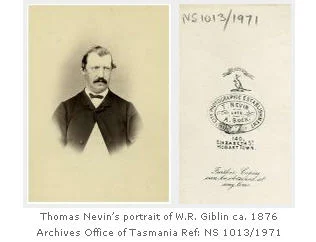
W. R. Giblin, photo by Thomas Nevin, AOT
- Superintendent Richard Propsting of the Hobart Municipal Police who appointed Thomas Nevin as special constable in 1879 during the Chiniquy riots, an appointment over and above his duties at the Municipal Police Office, Town Hall, where he was first active as an Office-Keeper in 1873, and subsequently appointed in 1876 as Keeper;

Superintendent Richard Propsting, 1870s [1879], AOT.
- the Crouch family: Thomas James Crouch had been Under-Sheriff until retirement in 1868, and a key figure in Wesleyan educational reforms. He was one of Alfred Bock's clients in the 1860s while Nevin was finishing his apprenticeship in Bock's studio, and Mayor by 1888;
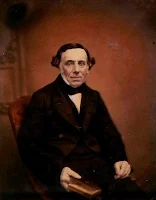
Under-Sheriff T. J. Crouch,
sennotype by Alfred Bock ca 1860, TMAG Collection
- Dr John Coverdale, a medical practitioner whose appointment as Surgeon-Commandant to replace A.H. Boyd at Port Arthur was resolved in the House of Assembly, October 1873. Coverdale was contracted to the Hobart Gaol as MD with "special duties", the term which also covered Nevin's contract, and performed inquests in Hobart and Launceston on prisoners.
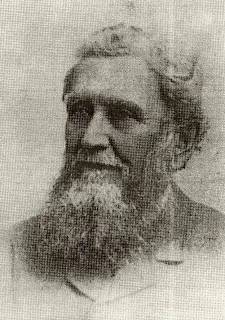
Dr John Coverdale, (in Weidenhofer 1981:43)
- and Samuel Page who held the government contracts for the Royal Mail coach deliveries between Hobart Launceston, and who contracted Nevin for photographic advertisements of his coachline. Samuel Page lived at Belle Vue, New Town, a villa with stables, paddocks and gardens. He transported prisoners under government contract from regional stations and courts to be "received" at H.M. Gaol, Hobart, accompanied by constables. With Samuel Page's patronage, Nevin travelled between Hobart and Launceston, combining commercial photography for Page, and police photography for the Municipal and Territorial Police [Sources: Hobart Town Gazettes 1870-1880; Tasmania Reports of Crime 1871-1875; AOT images; QVMAG images; TMAG images]

Samuel Page, ca. 1874. Private Collection.
As the police photographer, whose singular talent for remembering and recording faces was a decided asset to police in a period when verbal rather than visual documentation predominated, Nevin's other major asset was his familiarity gained from an early age with military and police methods of prisoner surveillance. Nevin had an ease in the company of gaolers and convicts. No other colonial photographer in Tasmania came with such apposite credentials for police work, certainly not Joshua Anson, apprentice to Nevin's friend and neighbour Henry Hall Baily whose studios faced each other across Elizabeth Street, Hobart Town in the late 1860s, for Joshua Anson pleaded to be kept apart from the prisoners when he was sentenced to two years at the Hobart Gaol for stealing from Baily because he said he "felt he was above them" although the jury thought otherwise [Sources:The Mercury June and July 1877].
THE POLICE PHOTOGRAPHS
The earliest date of Nevin's contractual arrangements with Attorney-General Giblin is late 1872, formalised in January 1873. By May 1874 Thomas Nevin was working closely with the newly appointed Surgeon Commandant Dr Coverdale at Port Arthur and Thos. Reidy at the H.M. Gaol for Males during the "booking photograph" phase of the transfer of prisoners from Port Arthur to municipal gaols and depots as the Port Arthur site was readying for closure. Most of the prisoners sent there from 1871 (over one hundred), when the site was transferred from Imperial to Colonial rule, had short-term convictions, and it was Nevin's job on their arrival back in Hobart to ensure a vignetted photograph was pasted to their criminal record and duplicates circulated to the police on their release in the event of recalcitrance.
The years 1873-76 proved to be one of the busiest periods at the Hobart Gaol and Police Office for Nevin. Attorney-General W.R. Giblin had notified the House of Assembly on July 17th, 1873 that sixty (60) short term prisoners who had been sent to Port Arthur since its transfer from Imperial to Colonial government in 1871 had already been returned to receiving depots and prisons in Hobart, and more would arrive shortly "as soon as arrangements for the proper custody and control of the Prisoners can be made on the Main Land [i.e. Tasmania, as distinct from the Tasman Peninsula]. By "proper custody and control" he was referring to additional cell accommodation, the recruitment of extra wardens and a photographer [Sources: Mitchell SLNSW Tas papers; Journals of the House of Assembly, NLA; Tasmania Reports of Crime 1867-1876, The Mercury June and July 1873].

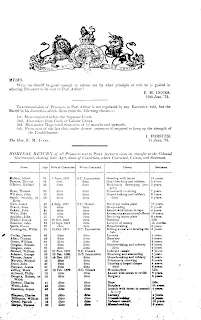
The names of 109 prisoners on short terms sentences transferred back to Hobart
Journals of the House of Assembly Tasmanian Parliament July 17, 1873
Attorney-General Giblin tabled a total of 109 prisoners in that session (1873), under pressure from investigation by Dr Crowther and others, suggesting Giblin's delay in the closure of Port Arthur was because the Commandant there was his brother-in-law, A.H. Boyd. The remaining 49 on the list had arrived in Hobart by 1874, in addition to the steady stream of long-termers and paupers destined for other depots, and if the criminal class of short-term inmate had not been photographed in transit at the Hobart Gaol, they were photographed on their recapture for additional offences. Many re-offended, were jailed several times from short terms of seven days to eight years or longer, and some died in custody. Only paupers were returned to Port Arthur from 1875, noted as a disgraceful ruin by photographer Alfred Winter accompanying tourists on a day trip (Mercury May 1876).
Among those on the parliament list were the two Gregson brothers, favorites enlisted by the A.H. Boyd apologists wishing to credit A.H. Boyd as photographer of prisoners at Port Arthur, most recently Julia Clark of the Port Arthur Historic Site.
Clark (unpublished 2007, after Reeder unpublished 1995, after Long unpublished 1984, after Wishart catalogue notes QVMAG unpublished ??, - we have here a clear case of "Chinese whispers") points to a document that has never been shown or cited in full, in which the Colonial Secretary Travers Solly supposedly requested the Commandant at Port Arthur - whom she says was A.H. Boyd despite the Australian Dictionary of Biography and Walch's Tasmanian Almanac (1873) recording his replacement by Dr Coverdale onJanuary 1st 1874 - to "send up" photographs of the two Gregson brothers who had absconded from a gang working on the Queens' Domain. The date Clark gives for Solly's request is January 9th, 1874. But the Gregsons had already left Port Arthur by the time they absconded from a place in Hobart called the Queen's Domain where they were housed under police supervision by Francis Norman who was employed by the Colonial Government on an annual salary of 200 pounds. The Gregsons were there when they absconded on January 9th 1874, not 60 kms away at Port Arthur on the Tasman Peninsula. They were photographed at the Police Office Hobart on February 18th 1874 after arrival from Launceston when arrested (see TAHO: CON37-1-1000498 and 9).
John and Francis Gregson, sentenced 18th Feb, 1874 at the Police Office, Hobart
TAHO Ref: CON37-1-1000498 and 9
The newspaper report of their capture in Launceston, their return on Samuel Page's coach in leg irons, and their incarceration at the Hobart Gaol appeared in The Mercury, 19th February 1874:
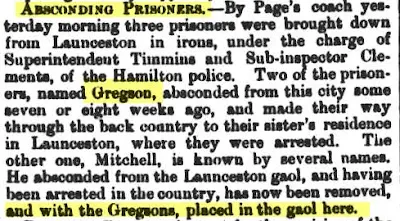
The Gregsons captured in Launceston, returned to Hobart Gaol
The Mercury 19 February 1874
These three absconders were photographed by Thomas Nevin at the Hobart Gaol in the same week, 15-19 February 1874: those booking photographs taken on that date are the ones that survive today. Boyd had nothing to do with these photographs. Yet Clark writes, and with calculated dishonesty to suppress the facts in an "essay"" padded with convictism and phony claims forwarded to the NLA, an assertion of her "belief" in A. H. Boyd as THE photographer of these men because:
page 12
On 9 January 1874, the Colonial Secretary B. Travers Solly wrote to Boyd to ask him for ‘half a dozen copies of the photographs of the two “Greigsons” (footnote 28)who absconded yesterday from the gang employed in the Domain. It will be a good plan to send up photographs of all prisoners transferred to Hobart Town and I would esteem it a
page 13 .
favour if you will do so at your early convenience’.(footnote 29) So by January 1874 it would seem that Boyd had already taken at least some photographs of the men in his charge. It also seems that he may have taken quite a number of photographs, since Travers is asking for more than just the 2 escapees. And in March 1874 Boyd wrote to the Colonial Secretary, advising him that he was forwarding photographs of ‘Alfred Harrington and James Kilpatrick, suspected of an intention to abscond’ (footnote 30)...
Footnote 29: Archives Office of Tasmania, D1470. Footnote 30: CSD7/1/60 file 1470, Archives Office of Tasmania.
These are not facts: these statements are fictions. They are lies, in essence. Clark wants her reader to believe that A.H. Boyd personally took several prisoners' photographs BECAUSE OF the Colonial Secretary's request on January 9, 1874, yet she also wants to claim he had already personally photographed them, Gregsons as an example, BEFORE that date, and at Port Arthur. These glib contradictions and deliberate elision of facts typify the arguments to credit Boyd with a photographer attribution. Clark's agenda is self-promotion, at any cost. There is no indication in this (unsighted) correspondence - the catalogue reference she gives for it at the Archives Office of Tasmania is also phony - that the photographer should have been, or was, or had ever been Boyd, who had no reputation as a photographer in his lifetime, and no works by him are extant now. Not even the suspect item held at the SLNSW which is claimed to be evidence of his photographic talent, is an original photograph, and it is the ONLY photograph in the last thirty years given an attribution to Boyd, and by library workers anxious to defend their cohort and mask their mistakes.
What is the item? See it in the ADDENDA below: A CLASSIC CASE OF PARASITIC ATTRIBUTION. It is a reprint by Beattie in the 1900s of an Anson's brothers' reprint dated at 1894 (SLNSW) of a single frame of a stereographic view, taken by Nevin or Clifford in the mid 1870s of a building at Port Arthur - not a prisoner ID mugshot of a man in prison clothing, but a simple prison building which has Boyd's name scribbled in pencil on the mount. It was accessioned by the SLNSW in 1964: it was not acquired by David Scott Mitchell in 1907 as were Nevin's original prisoner photographs held at the SLNSW.
Boyd's name which undersigned the transfer of paupers only -not convicted criminals - from Port Arthur to Hobart disappears abruptly from the police records after February 1873.
The newspaper reports and police gazettes of the day tell a different story altogether about the Gregsons:


Francis and John Gregson, photographed by Thomas Nevin H.M. Gaol, Hobart, on their arrest February 20th, 1874. Their duplicates are held at the NLA, the TMAG, and the AOT.
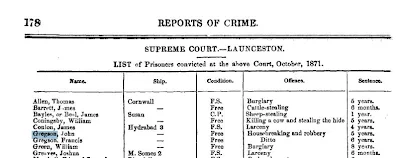
Gregson brothers convicted , 9th October, 1871 for five and six year sentences.
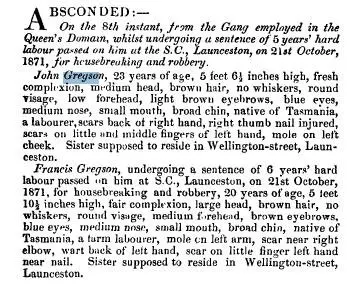
Gregsons absconded January 9th, 1874

The Gregsons were arrested on February 19th, 1874, received from Launceston and photographed at the Police Office, Hobart Town Hall. Men who were arrested in Launceston and the regions but who would be incarcerated for longer than three months were transferred on Samuel Page's coaches to the Hobart Gaol. They were not photographed before their arrival at Hobart.
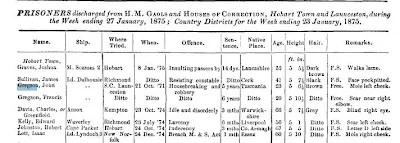
The Gregsons were discharged 27th January, 1875, and may have been photographed again by Nevin in the preceding week. They were not photographed at Port Arthur before January 9th, 1874. They escaped from the Domain in Hobart on that date and were photographed on arrest one month later by Nevin when they were received at the Hobart Gaol. These two brothers re-offended on a regular basis every few months right up to 1879, and may have been photographed once again by the Nevin brothers in 1878 at the Supreme Court, Hobart.
Source: Tasmania Reports of Crime Information for Police 1871-1885. J. Barnard, Gov't Printer.
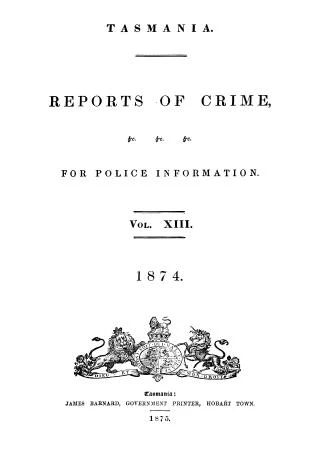
The majority of prisoner images extant in public collections today date from that busy period between 1873 and 1877 when the transfer of inmates with short-term convictions from Port Arthur was completed and the prisoner was "enlarged"- as the police called it - with a ticket-of-leave to work. The photographs and in some cases, the glass negatives, survived because they were salvaged by the government photographer in the late 1890s, John Watt Beattie, who reproduced them in various formats for sale as tourist tokens in his convictaria museum until 1927. The originals and duplicates from Nevin's negatives survive as random estrays from the Habitual Criminals Registers and Police Gazettes, a sample only of the more than a thousand photographs taken by the Nevin bothers between 1872 and 1892.
Some of the photographs ended up at the Queen Victoria Museum and Art Gallery, Launceston, others were transferred from the Municipal Police to the Tasmanian Museum and Art Gallery, and some were collected by David Scott Mitchell before 1907 (SLNSW).
Nevin's originals also survived as estrays from the Sheriff's office when they were transferred eventually to the Archives Office of Tasmania in 1955.
The Tasmanian Museum and Art Gallery acquired fifty or more of Nevin's convict cartes among a sizeable collection of Nevin's stereographs and commercial cartes which he had left at the Hobart Town Hall Public Library while Keeper there (1880s). Many of the TMAG photographic items acquired from that date bear the Hobart Municipal Library stamp. These were mixed in with duplicates forwarded to the TMAG from the QVMAG in the 1980s. Some had also been in the possession of the Kiosk owners at the Port Arthur site since the days when it was called The Old Curiosity Shop (and Radcliffe Museum), established during the tourist boom of the years 1890-1920s. A few remain at the old Hobart Gaol, displayed at the Penitentiary Chapel Historic Site. Port Arthur records were offered at auction in 1879 in Hobart and Melbourne in the face of public protest and a belief the government had ordered their destruction by 1876 (Source: Alison Alexander, Tasmania's Convicts 2010. Many later ID prisoner photos were burnt along with other prison and convict records during the Joseph Lyons terms of government. [Sources: AOT Pretyman Collections; QVMAG Beattie Collection; TMAG collections]
Thomas J. Nevin was the sole photographer working in Hobart prisons (and with Samuel Page's patronage, in Oatlands and Launceston as well) in the 1870s for this type of identification documentation, that is, until he was joined by his brother Constable John Nevin (William John, known as John, and always as Jack by the family) who entered employment at H.M. Gaol first as a Constable (1875), and then under the wing of its Keeper, Ringrose Atkins (appointed 1874). John Nevin was armed during the transition phases of transfer of the Port Arthur prisoners to the gaol (1875-1877), in all likelihood to protect his brother, testified at an inquest into the death of a colleague in 1882, and maintained his administration position through to his untimely death in 1891, aged 39 yrs [Sources: AOT Colonial Families Links; Electoral Rolls for North Hobart 1877-1884; The Mercury, June 1879; 1882].
In 1875, the police gazettes documented Nevin's assistance rendered to the Territorial Police in New Town, and in 1876 his affiliations with the Municipal Police deepened with his appointment as Keeper (an archaic term indicating a manager of an archive and its house) of the Hobart Town Hall and Public Library, which also housed cells and the Police Offices. By 1878 he was the Office-Keeper for the Corporation. And in 1879, he was sworn in and armed as special constable during the Chiniquy riots at the Town Hall, when Catholics attempted to assault the Catholic renegade Canadian priest Charles Chiniquy and his supporters [Sources: The Mercury, January 1876; 1877; 1878; Tasmania Reports of Crime 1875].
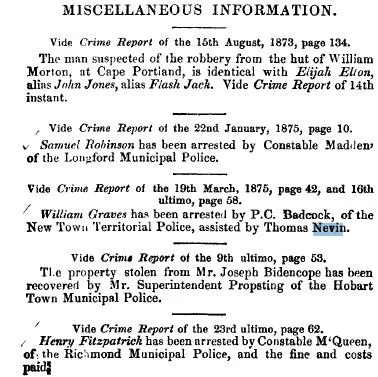
Nevin assisting police, Tasmania Reports of Crime Information for Police 1871-1875
TOWN HALL POLICE OFFICE
Along with other Hobart photographers of the 1870s, Thomas Nevin derived income from several sources to support his growing family (six survived to adulthood, the first was born in 1872, the last in 1888). Charles A. Woolley sold furniture, Samuel Clifford had a grocer's shop, and Henry Hall Baily developed a thriving business in tourist postcards and press lithography. By December 1880, Nevin was still active as a photographer working with Baily (noted in The Mercury 4 December 1880), still a police photographer and agent on commission, always ready to respond to a constable's whistle, still a Wesleyan, and still a civil servant, until his sudden dismissal from the Town Hall position on December 4th 1880.
For being detained the night before on suspicion of acting in concert with a person pretending to be a ghost in a phosphorous-coated sheet down by the Customs House, but principally for being inebriated while on duty, he was sacked, but he was not arrested by the detaining detective Connor, who knew him well, and he had spent the evening in and out of hotels with two constables whom he had supposed were friends as well as colleagues. Although Mayor Burgess ostensibly mounted Nevin's defense, Burgess was a Temperance man, and Nevin's drinking was an embarrassment. At some point Thomas Nevin must have decided the Wesleyans weren't for him, despite his father's Trusteeship of the Wesleyan Chapel at Kangaroo Valley, and the taking of his wedding vows there in 1871. He was the only member of his immediate family to be buried at Cornelian Bay cemetery within the Church of England. The Town Hall experience of religious and sectarian violence during Chiniquy's visit, and then the death there of his son Sydney at 4 months old, and finally his dismissal, probably because of Temperance intolerance, changed his life. It was his brother Jack Nevin who continued within the prison administration as photographer until his death in 1891; Thomas Nevin continued to provide photographic services and bailiff duties working with police in the Courts and the MPO until ca. 1886. [Source: AOT Colonial Families Links; Electoral Rolls for North Hobart 1877-1884; The Mercury, June 1879, 1886, July 1888].
When in early December 1880 Thomas Nevin was dismissed from the position of "Keeper" at the Hobart Town Hall for inebriation while on duty, the Mayor's Committee expressed deep regret at the dismissal (reported in The Mercury December-January 1880-1881), and mindful of his growing family, the Council decided to retain his photographic services. Nevin was re-assigned to civil service with warrant and photographic duties as assistant bailiff with The Municipal Police Office, located at the Hobart Town Hall. Working principally in the City Police Court and Hobart Supreme Court as assistant to Sub-Inspector John Dorset(t), Nevin continued to provide identification photographs of prisoners up until 1889, a service he had provided for the Prisons Department and MPO since 1872. Many of these mugshots were collated with the Municipal Police Office issued warrants; two death warrants with Nevin's photographs of the condemned man attached (e.g. Sutherland 1883; Stock 1884) now survive intact in the Mitchell Collection at the State Library of NSW.
During the late 1880s-1900s, Nevin was still active in police matters, as his attendance at the important meeting on resolutions to the police centralisation bill attests, held in July 1888 (see The Mercury report above). He also maintained photographic practice, producing some enduring images of his family, but he turned his attentions to training horses, a love engendered in his youngest son Albert which has been passed onto Albert's children who maintain the pacing tradition today.
A memorable line:
"Mr. Thos Nevin was under the impression that the police should be under stricter supervision."
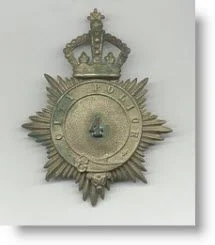
ADDENDA
The A.H. BOYD "PHOTOGRAPH": A CLASSIC CASE OF A PARASITIC ATTRIBUTION
In the 25 years since Chris Long first concocted the hypothesis that the Civil Commandant A.H. Boyd at the Port Arthur prison MAY HAVE taken ALL the extant photographs of Tasmanian convicts (about 300, which are nothing more than randomly salvaged estrays from police registers of thousands taken by the Nevin brothers), and which are conventionally dated to 1874 (letter to Nevin family 1984; TMAG 1995), just ONE photographic item has ever been cited by Chris Long or any other commentator as evidence of any photograph taken by A.H. Boyd. It is held at the State Library of NSW. And it is still the only item cited as so-called evidence of Boyd's photographic work (for example, the entry for Boyd at DAA online 2008: https://www.daao.org.au/main/read/977 - note the fatuous comment - "not surprising given his job as a penal officer").
Mitchell Library, SLNSW
Views in Tasmania, Vol. II, ca. 1885-1894 / Anson Brothers.
PXD 511/no. 10 ‘Port Arthur during convict occupation’
Taken at the SLNSW
Photo copyright © KLW NFC 2009 ARR
ABOVE: This is it: this is THE "photograph" with a note in modern hand-writing on the bottom right-hand corner, a REPRINT (Beattie 1900s) of an earlier reprint (Ansons 1890s) of an enlargement of a single frame of a stereograph by Clifford and Nevin 1873 which Chris Long firmly attributed to Clifford, reprinted by Beattie without attribution, cited in Tasmanian Photographers 1995:14)) of a building at Port Arthur.
Below this image used as the basis of the claim to be by A.H. Boyd from the album, (PXD511/ f10) is the pencilled note, ” Enlargement from a stereoscopic view by A H Boyd Esq.”
Detail (darkened) of above:
Mitchell Library, SLNSW
Views in Tasmania, Vol. II, ca. 1885-1894 / Anson Brothers.
PXD 511/no. 10 ‘Port Arthur during convict occupation’
Taken at the SLNSW
Photo copyright © KLW NFC 2009 ARR
This image of a building is not a vignetted carte-de-visite photograph of a man in prison clothing, yet the curator of photographs at the State Library of NSW, Alan Davies, is proposing it is sufficient evidence to warrant a claim that A.H. Boyd was a photographer, and to extend that claim to a proposition that Boyd was also the photographer of the “bulk” of the 300 extant prisoner cartes, despite all available evidence of attribution to Thomas J. Nevin.
As recently as August 2009, Alan Davies maintained that proposition, which is founded in the cliched equation “Tasmania + convicts = Port Arthur” in an email to this weblog, extracts of which are quoted here:
… the attribution of the several hundred portraits known as the convict photographs is unresolved … please see Anson Bros Views in Tasmania Vol II. (PXD511/ f10) The view looking south from the slope opposite the Penitentiary is inscribed on the mount in a contemporary hand “Enlargement from a stereoscopic view by A H Boyd Esq.” This view also appears in Anson Bros., Settlement of Port Arthur (Penal Settlement ) Past and Present. We have two copies (PXD512 and PXD513) and the references to the Boyd image in both are PXD 512/f4 and PXD 513/f6. Comparison of this photograph with the images in the Anson/Beattie collection titled Port Arthur during occupation , leads to the conclusion that they may also be by Boyd. It would seem that like many Tasmanian photographers, Boyd s work was subsumed by the Anson/Beattie archive, leading to later problems of attribution. (Alan Davies, email to this weblog August 2009)THE FACTS once more ...
(1) The reprint was acquired in 1964 by the SLNSW. The album itself was bound in red leather by the Royal Scottish Museum, owned by Capt A.W.F. Fuller in 1946, donated by his wife and accessioned by the State Library of NSW in 1964;
(2) The reprint was not part of the David Scott Mitchell Collection of Tasmaniana acquired there ca 1907, unlike T.J. Nevin's nine prisoner photographs (catalogued at PXB 274) which were accessioned before 1907 by Mitchell and bear no wording pertaining to Port Arthur;
(3) Other reprints in the same volume Vol. 2 (Anson Bros Views in Tasmania Vol II. (PXD511/ f10) were attributed to J.W. Beattie, as reprints in turn of the Anson Brothers reprints in Vol 1. so this reprint was attributed to the Ansons by the SLNSW through a process of deduction in 1964 by comparison with the same image in Vol. 1 which bears the Ansons' name. The note by the accessioning librarian puts the date of the albums at 1894, per this inscription on the inside cover of one of the volumes, also in a modern hand:

Mitchell Library, SLNSW
Views in Tasmania, Vol. II, ca. 1885-1894 / Anson Brothers.
PXD 511/no. 10 ‘Port Arthur during convict occupation’
Taken at the SLNSW
Photo copyright © KLW NFC 2009 ARR
Inscription by the SLNSW: "The first photo gives a scene taken in 1894 & this, doubtless, is the approximate date of the whole series of photos in these 2 Vols."
(4) The image is not an original photograph in vignetted carte-de-visite format of a man in prisoner clothing, as are the extant "convict portraits" by T.J. Nevin. It is simply NOT A PRISONER MUGSHOT.
(5) The image is of a prison building and empty streets, and the site looks decidedly unoccupied despite the title "Port Arthur during Occupation" which indicates it was taken in the site's dying days from 1873 onwards.
(6) An identical photograph of the one above is held at the Archives office of Tasmania, dated to 1880, and unattributed. Another is held at the TMAG with Clifford as the original photographer, and Beattie as the copyist (Long, 1995:14).
(7) None of the other prints in this album, Vol. 2, has a similar note or additional inscription on the mount, and this single fact raises questions and suspicions as to why and when it was added. In addition, the note about Boyd is so indistinct, not even a magnifying glass renders it visible.

Mitchell Library, SLNSW
Views in Tasmania, Vol. II, ca. 1885-1894 / Anson Brothers.
PXD 511/no. 10 ‘Port Arthur during convict occupation’
Taken at the SLNSW
Photo copyright © KLW NFC 2009 ARR
Can you see Boyd's name? It could easily have been added by the SLNSW or traced over another photographer's name, e.g. H.H. Baily Esq. See this article: Fraudulent Pretensions.
It would appear that this pencilled note underneath the image at the SLNSW was written sometime between 1984 and 1992 when Joan Kerr and Geoffey Stilwell publicly refuted Chris Long’s hypothesis about Boyd in their entry on Thomas J. Nevin (page 568, The Dictionary of Australian Artists: painters, sketchers, photographers and engravers to 1870, (Melbourne: Oxford University Press).
Someone then pencilled the note -
“Enlargement from a stereoscopic view by A H Boyd Esq.”
- to save Chris Long from looking like an idiot.
Parasitic attributions are spread by parasites. When Julia Clark submitted her student "essay" with her sycophantic "belief" in the "pre-emininent historian of photography Chris Long" (no he isn't- his derivative publication Tasmanian Photographers 1840-1940, TMAG 1995, was an A-Z desktop production copied from State Librarian Geoff Stilwell's Index and Joan Kerr's massive Dictionary -DAA- 1992), and his A.H. Boyd hypothesis in 2007, the National Library of Australia removed Thomas J. Nevin's name from the header of their collection of Convict Portraits, Port Arthur 1874 (http://nla.gov.au/nla.pic-an11590418) which was their accessioned and correct attribution since their acquisiton in 1964 and exhibitions 1982/1985, and replaced Nevin's sole attribution with this note:
No photographer name or studio stamp appears on these photographs. It is likely that the photographer was either A.H. Boyd or Thomas J. Nevin. An essay supporting attribution to Boyd, prepared by Julia Clark, Manager Interpretations and Collections, Port Arthur Historic Site, is on file (TRIM R07/44719); copies available on request.The National Library updated this catalogue entry in May 2010 with a reference to an article published by Clark, further abjecting Nevin's name from their accessioned and long-standing accreditation:
No photographer name or studio stamp appears on these photographs. Formerly attributed to Thomas J. Nevin, the portraits are now considered more likely to have been taken by A.H. Boyd. See: Julia Clark. A question of attribution: Port Arthur's convict portraits in Journal of Australian Colonial History, Vol 12, 2010, p77-97.; Part of collection: Convict portraits, Port Arthur, 1874.Julia Clark's article is drivel, a beggarly attempt to prop up the scaffolding of errors about A.H. Boyd through the plagiarism and abuse of materials from these Nevin weblogs, topic by topic, sentence by sentence and even word for word. This dead-end anomaly about Boyd was first raised on our weblogs back in 2005. Clark has had five years to come up with factual evidence: "considered more likely... " is not evidence, it is more evidence that there IS NO EVIDENCE. There never was an historical event where some one called A.H. Boyd photographed prisoners in Tasmania in the 1870s-1880s.
In her own words - and very few in this article ARE her own words apart from the archaeological fictions - Clark states clearly that there is no official record of A.H. Boyd taking prisoners' photographs, yet she persists in arguing his case:
Clark, p. 90, JACHS 2010
Photo © KLW NFC 2010 ARR
With craven dishonesty, Clark has the National Library technicians responsible for this egregious and capricious act of misattribution believing this rubbish. She firstly pushed onto them a pointless and irrelevant essay in 2007,the objective of which was to attack and discredit Nevin through abuse of his descendants, and now with this "article" which she hopes will mislead the public sufficiently into backing her "bet" on A.H. Boyd. To poor Julia Clark, the issue is all about descendants, so the question has to be asked: is she descended from a convict, is this green-eyed resentment masking the sting of the "convict stain" which motivates her malice? Or is she just a bully, hence the Boyd fascination?
Clark, JACHS 2010, p83
Photo © KLW NFC 2010 ARR
Look carefully at this excerpt from page 83 of the Journal of Australian Colonial History 2010: the Nevin descendants "make very public and strident claims" - no mention of course that reputable historians, Prof. Joan Kerr, State Librarian Geoff Stilwell and curator John McPhee were the authorities who researched Nevin's attribution in the decades 1970s-1990s with only BDM input from a branch of the Nevin family. No mention either that these weblogs have been documenting the misattribution at various main URLS since 2005, nor is there mention of the extensive print based articles and citations by watchers across the web with considerable expertise in fraudulent behaviour such as Clark's. This foolish individual has gorged herself on every topic/idea put forward on these weblogs since 2005 and re-presented them as her own, with no acknowledgment other than this pathetic little cock-a-snook. Her theft of our research has put her on notice to her publisher, the JACHS, to repress the article from online distribution; to her PhD supervisor Hamish Maxwell-Stewart; and to the Director at the University of Tasmania to suspend her candidacy. The Australian Copyright Council has been aware of Clark since 2009 when we placed more and more information with finer detail onto the weblogs, including photographs of convicts not available online at the Mitchell Library SLNSW or elsewhere and became aware of exactly what she was copying and downloading. We have no article posted on the date cited above: 6 September 2009, but most of our research concerning the Mitchell Library photographs by Nevin we had placed online by August 2009, together with snippets of relevant police records, which were then extensively plagiarised by Clark for the last half of her article. Read the sidebars here for our copyright remits.
Gossip, gambling and gleaning are the cornerstone of Clark's evidence and argument : she offers anecdotal evidence which was "gleaned" from A.H. Boyd descendants who "confidently recognise the images as his", sufficient to lay her "bet" on A.H. Boyd.
Clark, JACHS 2010, p.89
Photo © KLW NFC 2010 ARR
See also this critique by Tim Causer, Bentham Project, University College London.
Thomas J. Nevin and descendants are apparently one of the more recent examples in a long line of Clark's personal targets. See this article on her MO in Hobart museums by M. Anderson. Clark's attack on the "Georgian splendour school of history" is deeply ironic, given that this Commandant A.H. Boyd she so firmly wants to promote as the prisoners' photographer at Port Arthur was just that - a Georgian middle-class gent revelling in the spoils of his own corruption, a renowned bully reviled by the public in his own day. In Kay Daniel's words (1998), Clark's analytical method is hypocritical - it's "the view from the Commandant's verandah school of history" - which she proscribes while pretending solidarity with her target, whether Aborigines or convicts. Of course, "Nevin" is a name to conjure with in Australian culture: Clark has gone for the tall-poppy syndrome tactic of piggy-backing on the name while cutting down the poppy, and that raises questions about her psychological stability.
As Maragaret Anderson states, Clark admitted candidly:
We may have overstated the case in our determination to act as an emetic to the genteel antiquarianism of the ‘Georgian splendour’ school of history. We probably did, but the public loved it anyway. Or most of them did. [27]From M. Anderson, https://nma.gov.au/research/understanding-museums/MAnderson_2011.html
So there you have it: "to act as as an emetic". Julia Clark, the human suppository, is by her own admission just an irritant. Anderson's comments applaud Clark's use of "strategic political support" and this is Clark 's MO, first and foremost, attacking at the interpersonal level, attacking the establishment (in this case the National Library's longtime accreditation to Thomas J. Nevin) until they incorporate her.
It is NOT likely that A.H. Boyd ever held a camera, let alone produced the 300 extant prisoner mugshots for the Tasmanian Police, which are a random collection of estrays of a major larger corpus. What is true, however, is evidence of partisan and corrupt librarianship at the beck and call of Clark's personal aspirations enveloped in tourist propaganda. In short, what we see here, in cricketing terms, is ball-tampering and a bent umpire. The A.H. Boyd misattribution has wasted the time and effort of a generation with an interest in forensic and police photography. The stupidity of Clark and the personality politics of the National Library combined only ensures further waste.
THE PARASITIC ATTRIBUTION:
- Fraudulent pretensions
- Margaret Glover and the fabrication of photohistory
- Working with police and prisoners
- The A.H. Boyd misattribution at DAAO
- About those photographic glasses 1873
- Nepotism, corruption and Port Arthur 1873
- The QVMAG, Chris Long and A.H. Boyd
- "In a New Light": NLA Exhibition with Boyd misattribution
- Nevin's mugshots: the transitional pose and frame
- Anne-Marie Willis & Richard Neville on the Boyd misattribution
- Three significant prisoner cartes by T. J. Nevin
- Helen Ennis’ NLA publication ‘Intersections’ 2004
- Isobel Crombie and Helen Ennis: how misattribution can persist
- Laterality: Helen Ennis & the poses in Nevin's portraits
- A Question of Stupidity & the National Library of Australia





